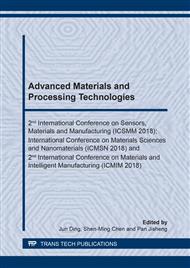[1]
W. Animaw, Y. Seyoum: Increasing prevalence of diabetes mellitus in a developing country and its related factors, PLoS ONE, Vol. 12 (2017) e0187670.
DOI: 10.1371/journal.pone.0187670
Google Scholar
[2]
C. Bommer, E. Heesemann, V. Sagalova, J. Manne-Goehler, R. Atun, T. Bärnighausen, S. Vollmer: The global economic burden of diabetes in adults aged 20–79 years: a cost-of-illness study, The Lancet Diabetes & Endocrinology, Vol. 5 (2017), pp.423-430.
DOI: 10.1016/s2213-8587(17)30097-9
Google Scholar
[3]
World-Health-Organization: Global Report on Diabetes, WHO Press, Geneva, Switzerland, (2016).
Google Scholar
[4]
X. Li, J. Liu, X. Ji, J. Jiang, R. Ding, Y. Hu, A. Hu, X. Huang: Ni/Al layered double hydroxide nanosheet film grown directly on Ti substrate and its application for a nonenzymatic glucose sensor, Sensors and Actuators B: Chemical,Vol. 147 (2010), pp.241-247.
DOI: 10.1016/j.snb.2010.03.018
Google Scholar
[5]
L. Liu, Z. Wang, J. Yang, G. Liu, J. Li, L. Guo, S. Chen, Q. Guo: NiCo2O4 nanoneedle-decorated electrospun carbon nanofiber nanohybrids for sensitive non-enzymatic glucose sensors, Sensors and Actuators B: Chemical, Vol. 258 (2018), pp.920-928.
DOI: 10.1016/j.snb.2017.11.118
Google Scholar
[6]
K.-C. Lin, L.-H. Huang, S.-M. Chen: Electrochemical synthesis of mixed-valence manganese/copper hybrid composite using graphene oxide and multi-walled carbon nanotubes for nonenzymatic glucose sensor, Journal of Electroanalytical Chemistry, Vol. 735 (2014), pp.36-42.
DOI: 10.1016/j.jelechem.2014.10.009
Google Scholar
[7]
K.-C. Lin, Y.-C. Lin, S.-M. Chen, A highly sensitive nonenzymatic glucose sensor based on multi-walled carbon nanotubes decorated with nickel and copper nanoparticles, Electrochimica Acta, Vol. 96 (2013), pp.164-172.
DOI: 10.1016/j.electacta.2013.02.098
Google Scholar
[8]
G.-h. Wu, X.-h. Song, Y.-F. Wu, X.-m. Chen, F. Luo, X. Chen: Non-enzymatic electrochemical glucose sensor based on platinum nanoflowers supported on graphene oxide, Talanta, Vol. 105 (2013), pp.379-385.
DOI: 10.1016/j.talanta.2012.10.066
Google Scholar
[9]
G. Wang, X. He, L. Wang, A. Gu, Y. Huang, B. Fang, B. Geng, X. Zhang: Non-enzymatic electrochemical sensing of glucose, Microchimica Acta, Vol. 180 (2013), pp.161-186.
DOI: 10.1007/s00604-012-0923-1
Google Scholar
[10]
L.T. Hoa, J.S. Chung, S.H. Hur, A highly sensitive enzyme-free glucose sensor based on Co3O4 nanoflowers and 3D graphene oxide hydrogel fabricated via hydrothermal synthesis, Sensors and Actuators B: Chemical, Vol. 223 (2016), pp.76-82.
DOI: 10.1016/j.snb.2015.09.009
Google Scholar
[11]
S. Yadav, R. Devi, P. Bhar, S. Singhla, C.S. Pundir: Immobilization of creatininase, creatinase and sarcosine oxidase on iron oxide nanoparticles/chitosan-g-polyaniline modified Pt electrode for detection of creatinine, Enzyme and Microbial Technology, Vol. 50 (2012), pp.247-254.
DOI: 10.1016/j.enzmictec.2012.01.008
Google Scholar
[12]
Z. Zhang, Z. Chen, F. Cheng, Y. Zhang, L. Chen: Highly sensitive on-site detection of glucose in human urine with naked eye based on enzymatic-like reaction mediated etching of gold nanorods, Biosensors and Bioelectronics, Vol. 89 (2017), pp.932-936.
DOI: 10.1016/j.bios.2016.09.090
Google Scholar
[13]
J. Balamurugan, T.D. Thanh, G. Karthikeyan, N.H. Kim, J.H. Lee: A novel hierarchical 3D N-Co-CNT@NG nanocomposite electrode for non-enzymatic glucose and hydrogen peroxide sensing applications, Biosensors and Bioelectronics, Vol. 89 (2017), pp.970-977.
DOI: 10.1016/j.bios.2016.09.077
Google Scholar
[14]
W. Bu, Z. Chen, F. Chen, J. Shi: Oleic Acid/Oleylamine Cooperative-Controlled Crystallization Mechanism for Monodisperse Tetragonal Bipyramid NaLa(MoO4)2 Nanocrystals, The Journal of Physical Chemistry C, Vol. 113 (2009), pp.12176-12185.
DOI: 10.1021/jp901437a
Google Scholar
[15]
S. Mourdikoudis, L.M. Liz-Marzán: Oleylamine in Nanoparticle Synthesis, Chemistry of Materials, Vol. 25 (2013), pp.1465-1476.
DOI: 10.1021/cm4000476
Google Scholar
[16]
A. Dong, J. Chen, P.M. Vora, J.M. Kikkawa, C.B. Murray: Binary nanocrystal superlattice membranes self-assembled at the liquid–air interface, Nature, Vol. 466 (2010), p.474.
DOI: 10.1038/nature09188
Google Scholar
[17]
F.N. Sayed, V. Polshettiwar: Facile and Sustainable Synthesis of Shaped Iron Oxide Nanoparticles: Effect of Iron Precursor Salts on the Shapes of Iron Oxides, Scientific Reports, Vol. 5 (2015), p.9733.
DOI: 10.1038/srep09733
Google Scholar
[18]
Y. Xu, A.V. Ruban, M. Mavrikakis: Adsorption and Dissociation of O2 on Pt−Co and Pt−Fe Alloys, Journal of the American Chemical Society, Vol. 126 (2004), pp.4717-4725.
DOI: 10.1021/ja031701+
Google Scholar
[19]
T. Brooks, C.W. Keevil: A simple artificial urine for the growth of urinary pathogens, Letters in Applied Microbiology, Vol. 24 (2003), pp.203-206.
DOI: 10.1046/j.1472-765x.1997.00378.x
Google Scholar
[20]
D. Pletcher: Electrocatalysis: present and future, Journal of Applied Electrochemistry, Vol. 14 (1984), pp.403-415.
Google Scholar
[21]
G. Gnana kumar, G. Amala, S.M. Gowtham, Recent advancements: key challenges and solutions in non-enzymatic electrochemical glucose sensors based on graphene platforms, RSC Advances, Vol. 7 (2017), pp.36949-36976.
DOI: 10.1039/c7ra02845h
Google Scholar


